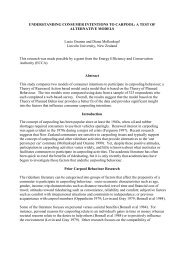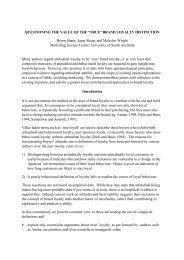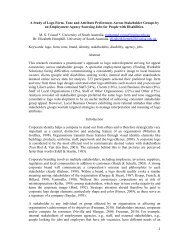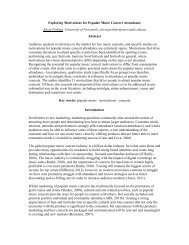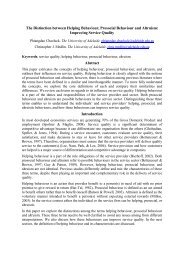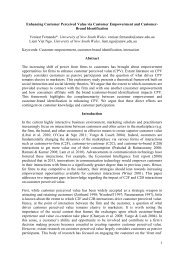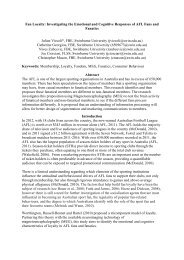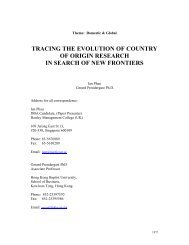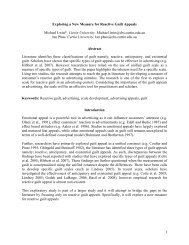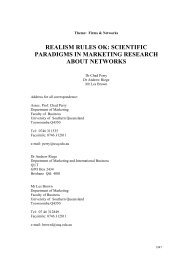1 CO-CREATION: A TYPOLOGY AND CONCEPTUAL ... - ANZMAC
1 CO-CREATION: A TYPOLOGY AND CONCEPTUAL ... - ANZMAC
1 CO-CREATION: A TYPOLOGY AND CONCEPTUAL ... - ANZMAC
You also want an ePaper? Increase the reach of your titles
YUMPU automatically turns print PDFs into web optimized ePapers that Google loves.
1<br />
<strong>CO</strong>-<strong>CREATION</strong>: A <strong>TYPOLOGY</strong> <strong>AND</strong> <strong>CO</strong>NCEPTUAL FRAMEWORK<br />
Pennie Frow, University of Sydney. pennie.frow@sydney.edu.au<br />
Adrian Payne, University of New South Wales. a.payne@unsw.edu.au<br />
Kaj Storbacka, Hanken School of Economics. kaj.storbacka@hanken.fi<br />
Keywords: co-creation, co-production, taxonomy, conceptual framework.<br />
Abstract<br />
Much of the extant literature discusses co-creation and co-production at a summative level, either<br />
treating these terms as interchangeable or suggesting distinctions between them. There is little<br />
discussion that explores different forms of co-creation. The purpose of this research is to explore<br />
the concept of co-creation, identify key forms of co-creation and to develop a conceptual<br />
framework for co-creation design,<br />
Co-Creation<br />
The MSI Research Priorities 2010-2012 highlight the imperative for research “to improve firms‟<br />
capabilities for co-creation”. We argue that deconstructing co-creation into more discrete forms<br />
has considerable benefit as it can assist firms to focus on a more innovative range of co-creation<br />
opportunities. The purpose of this research is to identify key co-creation forms and to develop a<br />
conceptual framework for co-creation design. Our theoretical contribution is twofold: (1) we<br />
identify a co-creation typology; and, (2) we develop a conceptual framework for co-creation<br />
design. Our managerial contribution is to provide practitioners with a tool for identifying new cocreation<br />
opportunities.<br />
Many authors discuss value co-creation in terms of co-production (e.g., Bendapudi and Leone<br />
2003). However, more recently, scholars argue that co-production is distinct from co-creation,<br />
describing customer involvement in the core offering and is a subcategory of co-creation (Vargo<br />
and Lusch 2008). Various other aspects of co-creation have been explored, including: the output<br />
of co-creation (Jaworski and Kohli 2006); competing through service (Lusch, Vargo and O‟Brien<br />
2007); management issues (Etgar 2006); and, the process of co-creation (Prahalad and<br />
Ramaswamy 2004; Payne, Storbacka, and Frow 2008). However, much of the work is at a<br />
general level and there is little discussion that identifies and explores different forms of cocreation.<br />
Further, an extended perspective is required, encompassing the interaction and<br />
integration of resources amongst multiple actors.<br />
Despite several attempts to define value co-creation, the concept remains vague (Prahalad and<br />
Ramaswamy 2004) and requires clarification. From our review of this literature we conclude that<br />
co-creation of value includes: (1) active involvement between at least two „actors‟; (2) the<br />
integration of resources that creates novel and mutually beneficial value; (3) a willingness to<br />
interact and co-create and, (4) a „spectrum‟ (Sheth and Uslay 2007) of potential forms of<br />
collaboration. Drawing upon this work we define co-creation as: “An interactive process,<br />
involving at least two willing resource integrating actors, which are engaged in specific form(s)<br />
of mutually beneficial collaboration, resulting in value creation for those actors.”
2<br />
Research Approach<br />
In our research we follow Reibstein, Day and Wind (2009) who point to the importance of<br />
engaging with managers to design new tools by practitioner involvement. We utilize „interactive<br />
research‟ (Gummesson 2002) where interactions with managers “play a crucial role” in testing<br />
concepts (p. 345). Our approach is qualitative involving the three phases explained in Table 1.<br />
Table 1: Research Approach<br />
Forms of Co-Creation<br />
Our objective is to develop a typology, not a taxonomy of mutually exclusive and exhaustive sets<br />
of co-creation forms. As Doty and Glick (1994) identify, typologies do not provide rules for
3<br />
classification, instead they identify multiple ideal types that may be partly overlapping. From the<br />
interactive research process, described in Table 1, we ultimately developed a final typology (see<br />
Table 2): consisting of 12 types of co-creation co-conception of ideas; co-design; co-production;<br />
co-promotion; co-pricing; co-distribution; co-consumption; co-maintenance; co-outsourcing; codisposal;<br />
co-experience; and co-meaning creation. A future full length journal article will provide<br />
fuller details of this co-creation typology including: a detailed description of each type; evidence<br />
and illustrations of organizations adopting them; and, relevant supporting literature.<br />
Table 2: A Typology of Forms of Co-Creation<br />
Conceptual Framework for Co-Creation Design<br />
In Figure 1, we show the five key components of the conceptual framework for co-creation<br />
design that were identified as a result of the research process explained in Table 1. Our approach<br />
involved exploring the complex process of co-creation design and its components, considering<br />
the relationship between these components and representing them within a conceptual<br />
framework. The co-creation framework in Figure 1 draws on the interactive research with<br />
executives and insights from business model design, stakeholder and actor perspectives in<br />
relationship marketing, learning processes, engagement platforms as well as prior work on cocreation.<br />
In the central section of the framework in Figure 1, we show the 12 types of co-creation<br />
described above. These forms represent options available to the focal actor in designing,<br />
influencing or responding to co-creation opportunities involving a broad range of actors. Each<br />
form of co-creation provides an opportunity for actors to collaborate and enhance the value<br />
shared within the context of a marketing system. In a specific context, some forms will be more
4<br />
appropriate than others, but their identification highlights potential opportunities for designing<br />
value enhancements through collaboration. As noted earlier, the 12 forms of co-creation include<br />
two broad categories. The ten forms of co-creation depicted horizontally in Figure 1 are more<br />
discrete in nature. The two forms of co-creation depicted vertically, co-meaning creation and coexperience,<br />
are more aggregative and cumulative in nature and may be impacted other forms of<br />
co-creation. The arrows in the central section of Figure 1 represent the iterative and recursive<br />
nature of collaborative co-creation activities, with the focal firm and particular actors influencing<br />
each other in an ongoing interactive process of resource integration.<br />
Figure 1: Conceptual Framework for Co-Creation Design<br />
The left section in Figure 1 represents the focal actor (firm) and its business model. When a focal<br />
actor designs co-creative activities, it seeks to achieve mutual benefit for itself and the other<br />
resource integrating actors. A business model can be understood as “the design or architecture of<br />
the value creation, delivery and capture mechanisms” (Teece 2010, p. 191). Business models are<br />
typically governed by overriding design themes (Zott and Amit 2010) that define the main design<br />
principles, how resources are configured and how capabilities are utilized. Co-creation can be<br />
viewed as a design theme around which business model elements are organized. A firm wishing<br />
to engage in co-creation needs to design an „open‟ business model that permits customers and<br />
other actors to interact with and influence design elements. Here, we utilize Nenonen and<br />
Storbacka‟s (2010) representation of business models and their interrelated elements of design<br />
principles, resources, and capabilities.<br />
On the right hand section of Figure 1 we identify categories of external actors, or „actor groups‟<br />
that have potential for engaging in co-creative activity. Because a firm may be concerned with<br />
identifying relevant actors beyond the domain of its customers and exploring co-creation<br />
opportunities with them, we reviewed different stakeholder models that provide guidance on<br />
actor identification. Following a review of several relationship marketing stakeholder<br />
frameworks, we integrate here key elements from the Ross and Robertson (2007) and<br />
Christopher, Payne and Ballantyne (1991) models. While much of the discussion on co-creation
5<br />
focuses on the focal actor (firm) and another actor (usually the customer), each of the forms of<br />
co-creation can also occur within and between actors, even without the direct involvement of the<br />
focal actor. This is reflected in Figure 1 with the black arrows on the right side of the actor<br />
groups indicating potential inter-actor co-creation and short grey arrows on the left side of each<br />
actor group indicating the potential for intra-actor co-creation (e.g., co-conception or co-design<br />
activities within a customer brand community).<br />
The focal firm may design its business model to support collaboration, but this alone does not<br />
ensure successful engagement. To support co-creation, a focal firm should consider development<br />
of an engagement platform (shown in the lower section of Figure 1), or gain access to a platform<br />
provided through a third party, with the purpose of attracting actors to become involved in<br />
relevant form(s) of co-creation. Engagement platforms are where knowledge is stored,<br />
categorized and shared through interaction between and within actors (Sawhney, Verona and<br />
Prandelli 2005; Ramaswamy and Gouillart 2010).<br />
The inter-actor and intra-actor learning processes, shown in the lower section of Figure 1,<br />
represent a key element in co-creation. A focal actor wishing to engage in design co-creation<br />
needs to influence other actors involving inter-actor learning so that their views regarding the<br />
benefits of co-creation become a shared construction. Intra-actor learning occurs within actor<br />
groups such as customer brand communities. Where multiple actors are involved, a number of<br />
factors impact on this learning including trust, commitment and how coordination is facilitated.<br />
Although each actor within a marketing system may be involved in a range of collaborations, a<br />
sustained involvement is likely only when the outcome is beneficial to those actors. A focal firm<br />
will typically utilize a planned design approach in seeking co-creation opportunities. However,<br />
not all value co-creation opportunities can be planned. Some may emerge more organically as<br />
new combinations of resources are found to create new value-enhancing opportunities.<br />
Discussion<br />
The conceptual framework shown in Figure 1 aims at enabling a focal actor (firm) to more<br />
purposely design its co-creation activities. By engaging in more purposeful and focused cocreation<br />
activities the focal actor is more likely to engage in value enhancing co-creation. Our<br />
work represents a further step towards understanding co-creation. However, much research<br />
remains to be done in exploration of the multifaceted field of co-creation. Our work also has<br />
limitations that also point to specific opportunities for further research. First, empirical work and<br />
detailed case study research will provide additional insights relevant to applying our framework<br />
in diverse contexts, including both business and consumer markets. Such empirical work could<br />
also include understanding customers‟ interest in engaging in different forms of co-creation in<br />
different product contexts and how this may vary across different customer segments. Second,<br />
other forms of co-creative activity may emerge through further investigation. Third, the extent of<br />
the broader actor involvement in co-creation, beyond the customer-supplier actor dyad, needs<br />
fuller exploration. Fourth, we suggest investigation of the process of co-creation in specific<br />
contexts, as some forms of co-creation are commonly used whilst other forms are relatively<br />
unexplored. Exploring firms in different industry sectors and contexts and identifying the<br />
opportunity for adopting less-developed forms of co-creation offers a further topic for
examination. Further work remains to be done to unravel such complexity and discover the full<br />
extent of opportunities to use co-creation in an increasingly collaborative world.<br />
REFERENCES<br />
Adams, R., Bessant, J., Phelps, R., 2006. Innovation management measurement: a review.<br />
International Journal of Management Reviews 8 (1), 21-47.<br />
Bendapudi, N., Leone, R., 2003. Psychological implications of customer participation in coproduction.<br />
Journal of Marketing 67 (1), 14-28.<br />
Christopher, M., Payne, A., Ballantyne, D., 1991. Relationship Marketing: Bringing Quality,<br />
Customer Service and Marketing Together. Butterworth Heinemann, Oxford, UK.<br />
Doty, D. H., Glick, W., 1994, Typologies as a unique form of theory building. The Academy of<br />
Management Review 19 (2), 230-251.<br />
Dubois, A., Gadde, L-E., 2002. Systematic combining: an abductive approach to case research.<br />
Journal of Business Research 55 (7), 553-560.<br />
Etgar, M., 2006. Co-Production of services: a managerial extension, in The Service-Dominant<br />
Logic of Marketing: Dialog, Debate and Directions, R. F. Lusch and S. L. Vargo, eds. M.E.<br />
Sharpe, Armonk, NY, 128-138.<br />
Gummesson, E., 2002. Practical value of adequate marketing management theory. European<br />
Journal of Marketing 36 (3), 325–349.<br />
Jaworski, B., Kohli, A.K., 2006. Co–Creating the voice of the customer, in The Service-<br />
Dominant Logic of Marketing: Dialog, Debate and Directions, R. F. Lusch and S. L. Vargo,<br />
eds. M.E. Sharpe, Armonk, NY, 109-117<br />
Lusch, R.F., Vargo, S.L., O‟Brien, M., 2007. Competing through service: insights from servicedominant<br />
logic. Journal of Retailing 83 (1), 5–18.<br />
Lusch, R.F., Vargo, S.L., Tanniru, M., 2010. Value networks and learning. Journal of the<br />
Academy of Marketing Science 38 (1), 19-31.<br />
Payne, A., Storbacka, K., Frow, P., 2008. Managing the co-creation of value. Journal of the<br />
Academy of Marketing Science 36 (1), 83-96.<br />
Prahalad, C.K., Ramaswamy, V., 2004. The Future of Competition: Creating Unique Value with<br />
Customers. Harvard Business School Press, Boston, MA.<br />
Ramaswamy, V., Gouillart, F. 2010. The Power of Co-Creation. Free Press, New York.<br />
Reibstein, D. J., Day, G., Wind, J., 2009. Is marketing losing its way? Journal of Marketing 73,<br />
1–3.<br />
Ross, W., Robertson, D., 2007. Compound relationships between firms. Journal of Marketing 71<br />
(July), 108-123.<br />
Sawhney, M., Verona G., Prandelli, E., 2005. Collaborating to compete: the internet as a platform<br />
for customer engagement in product innovation. Journal of Interactive Marketing 19<br />
(Autumn), 4-17.<br />
Sheth, J., Uslay, C., 2007. Implications of the revised definition of marketing: from exchange to<br />
value creation. Journal of Public Policy and Marketing 26 (2), 302-307.<br />
Teece, D. J., 2010. Business models, business strategy and innovation. Long Range Planning, 43<br />
(2/3), 172-194.<br />
Vargo, S. L., Lusch, R.L., 2008. From goods to service(s): divergences and convergences of<br />
logics. Industrial Marketing Management 37 (3), 254-259.<br />
Zott, C., Amit, R., 2010. Business model design: an activity system perspective. Long Range<br />
Planning, 43 (2/3), 216-226.<br />
6




